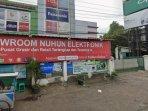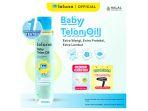Kunci Jawaban
Kunci Jawaban Bahasa Inggris Kelas 11 SMA Kurikulum Merdeka Hal. 71: Unit 2. Love Your Environment
Simak kunci jawaban Bahasa Inggris kelas 11 SMA/MA/SMK Kurikulum Merdeka, buku siswa Bahasa Inggris: English for Change halaman 70-71.
Penulis: Tiara A. Rizki | Editor: Tiara A. Rizki
TRIBUNNEWSBOGOR.COM - Simak kunci jawaban mata pelajaran Bahasa Inggris kelas 11 SMA/MA/SMK Kurikulum Merdeka, halaman 70-71.
Kunci jawaban ini membahas soal dari materi yang dimuat dalam buku siswa Bahasa Inggris: English for Change untuk SMA/MA Kelas XI, Unit 2: Love Your Environment.
Dalam pembahasan kunci jawaban ini, siswa harus membaca terlebih dahulu Text 2.
Selanjutnya, siswa diminta untuk mengerjakan tugas, menentukan benar atau salah tiga pernyataan yang disediakan berdasarkan bacaan tersebut.
Siswa juga diminta menunjukkan bagian dari teks yang mendukung pernyataan itu.
Adapun kunci jawaban dalam artikel ini dibuat hanya sebagai referensi belajar siswa untuk mengerjakan soal secara mandiri.
Perlu dicatat pula, paparan soal dan kunci jawaban dalam artikel ini hanya ditujukan kepada orangtua untuk memandu proses belajar.
Selain itu, apabila siswa masih mengalami kesulitan menyerap materi, harap segera mengajukan pertanyaan atau diskusi dengan guru.

Baca juga: Kunci Jawaban Bahasa Inggris Kelas 9 SMP Kurikulum Merdeka Hal. 326-328: Steps to Spot Fake News
Baca juga: Kunci Jawaban Bahasa Inggris Kelas 8 SMP Kurikulum Merdeka Hal. 207: Plastics in The Ocean
Baca juga: Kunci Jawaban Bahasa Inggris Kelas 9 SMP Kurikulum Merdeka Hal. 340-341: Progress Check 2
Text 2
From the 1950s to 2015, the production of plastic products grew from virtually zero to about 350 million tons per year. This continuous increase has resulted in a cumulative total of 7.8 billion tons of plastic produced during this period, corresponding to more than one ton of plastic for each person alive as of the end of 2015.
Up until the 1980s, the idea of recycling plastic was unheard of. From the 1950s to the 1980s, plastics were either simply discarded into landfills or incinerated. From the onset of plastic recycling in the 1980s to the present, the portion of plastic products that were recycled increased by an average of 0.7 persen per year.
As of the end of 2015, a staggering 55% of all plastic products end up in landfills. This corresponds to about 4600 million tons of accumulated plastic waste over the years. About 700 million tons of plastic waste has been incinerated and about 2500 million tons remain in active use.
Of the entire volume of plastics that have been produced since the 1950s, only 500 million tons (roughly 6%) have been recycled. Of this portion, only 100 million tons remain in active use. The other 400 million tons have also ended up either getting discarded in landfills or incinerated. Around 3% of plastic waste produced annually ends up in oceans – or about 8 million tons by the end of 2015.
By use, packaging of goods constitutes the greatest volume of usage of plastic products at around 141 million tons. The next category has a volume of less than half – the building and construction industry at only 65 million tons. This emphasizes how heavy plastic production can be reduced by using non-plastic alternatives for product packaging. Looking at the plastic production rates per country, China leads the pack by a huge margin at around 60 million tons. The US comes in at second at 38 million tons.
Now state whether the statement is true or false, and show which part of the text supports the statement.
| Kunci Jawaban Bahasa Inggris Kelas 7 SMP Kurikulum Merdeka Hal. 159: Borrowing English Dictionary |

|
|---|
| Kunci Jawaban Bahasa Inggris Kelas 7 SMP Kurikulum Merdeka Hal. 17: A boy is introducing himself |

|
|---|
| Kunci Jawaban Bahasa Inggris Kelas 9 SMP Kurikulum Merdeka Hal. 340: Direct-Indirect Speech |

|
|---|
| Kunci Jawaban Bahasa Inggris Kelas 8 SMP Kurikulum Merdeka Hal. 152-153: What trash is recyclable? |

|
|---|
| Kunci Jawaban Bahasa Inggris Kelas 10 SMA Kurikulum Merdeka Hal. 81: Healthy and Less Healthy Foods |

|
|---|














Isi komentar sepenuhnya adalah tanggung jawab pengguna dan diatur dalam UU ITE.